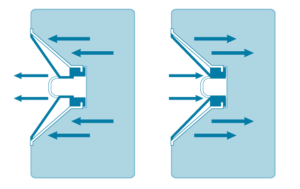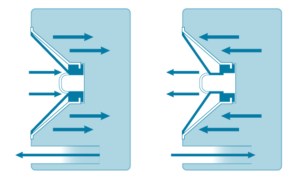Enclosure Design
1. AATC simulates and validates enclosure design based on the following process.
- Suggesting the geometry of the final product, with the knowledge of measured T/S parameters.
- Create mockups using 3D printing and test their acoustic performance.
- Compare the simulated and measured results, find out the difference and improve the predictability.
- By iterating the above process, we arrive at a final design proposal.
2. Below shows several prevailing enclosure designs.
- Sealed enclosure
The back volume of these kinds of enclosures is sealed tightly, prohibiting the back air from leaking. The absence of venting holes and ports raises the air compliance, which results in stronger “air spring” effect, limiting diaphragm excursion. As excursion is limited, the sound pressure level is limited, all else equal. A way to compensate is to input higher power, while beware of heat dissipation and prevent coil breakdown.
- Bass reflex enclosure
To release the sound energy otherwise trapped in the back volume, a sound port can be added either on the front or the back of the speaker. This can help raise the total sound pressure traveling to the front. On the other hand, venting helps decrease the air stiffness in the enclosure, which will improve the lower-to-mid frequency response.
The area of the port inlet and the length of the port will impact the response. Some wind noise may occur if the sound port geometry isn’t right or the if the port area is too small. Particularly, at the Helmholtz resonant frequency, there will be significant air flow in the port, with little to no vibration on the speaker diaphragm.
Another interesting fact is that there’s a type of enclosure called “transmission line enclosure”. The design features a very long, winding and twisted sound port, which functions as a Low Pass Filter (LPF). The chamber in the enclosure works as compliance, the sound port as inertance, together forming the idea of transmission line-LPF.
- Passive radiator
Passive radiator is a speaker without any electromagnetic device, simply consisting of a diaphragm, spider and basket. The speaker won’t be driven by electrical power actively, but will just passively vibrate in the airflow produced by the main speaker- the active one. The passive radiator is situated on a special opening, sometimes at the end of a venting tube, and it well resembles a regular driven speaker at first glance. The air stiffness is reduced by the radiator’s soft diaphragm, allowing more low frequency extension. The added compliance makes this kind of design very common in home audio and other high end applications. A pitfall is that THD might rise if the active-passive design misaligns. One of the solutions is to choose a passive radiator with a diaphragm smaller than that of the active one.
To further decrease air stiffness, sound absorbing material such as fiberglass and sponge can be put in the enclosure. The locations of the material can be arranged to mitigate standing waves as they can stand in the path of peaks and dips. In the case of closed box, the system compliance is
Where VB is closed box area, unit in m3; p is the density of the stuffed material, unit in kg/ m3; c is the sound speed in the stuffed material, unit in m/s. After stuffing the fiberglass or sponge, usually pc2 decreases and CAB increases. To dig into the effect of the stuffed material, we introduce another form of CAB expression.
The above equation is another equivalent expression for volume, where is related to the ideal gas law (PV=nRT), defined as:
, Here,
represents the percentage change in pressure, and
represents the percentage change in volume.
indicates how much the pressure increases when the volume of the ideal gas decreases by 1%. It is the atmospheric pressure N/m2N/m^2N/m2.
Based on the ideal gas law, if it weren’t for the stuffed material, the temperature would rise if the air was compressed. This assumes that the heat has no time to spread out to the environment, and under this circumstance of heat insulation, the compression is called an adiabatic compression. But what happens when stuffed material exists? The material absorbs heat and increases the heat capacity, transmitting the heat to the material. This is called isothermal compression.
Note that of isothermal compression is 1; while
of adiabatic compression is 1.41. Ideally
, which means the acoustic compliance increases by 41% after we put in the stuffed material. In reality, the stuffed material usually increases the air compliance by only 15%~20%. Adding the material will also add the system’s damping factor, and flatten the impedance curve. Moreover, the vibrating mass will also increase because now the stuffed material is vibrating along with the speaker’s diaphragm.



